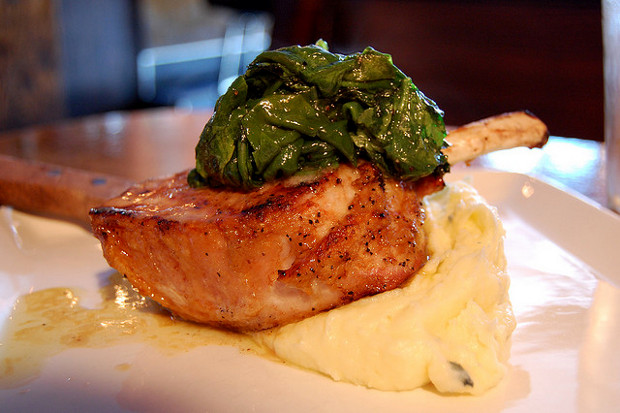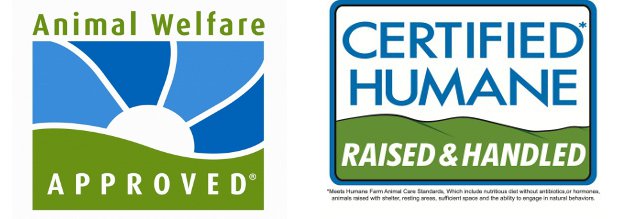
The Definitive Guide to Pork
Written by KristenM

In response to last week’s post on the healthfulness of pork, I received a number of emails asking questions like this one:
“Loved your article on pork, but I’m really confused about the real meanings of marinated, unmarinated, cured, uncured, etc. when buying pork today, and what to actually look for on labels. Please add more info, if possible.”
I’d never before considered that the world of pork labeling could be nearly as confusing as, say, the world of egg labeling. But it is. It totally is. As with egg labels, a lot of terms get thrown around on labels, and hardly anyone seems to know what they actually mean. Now you’ll know.
When I select pork, I consider first how the pig was raised and slaughtered. I know it’s hard to put any kind of factory farming on a sliding scale; it’s all bad (and arguably evil). But in my heart of hearts, factory pig farms are among the worst of the lot. Domesticated pigs are highly intelligent creatures, well adapted to living around people. This was, in fact, the common practice for thousands of years among pig-raising small homesteads. The conditions of the factory farm allow the pigs no expression of the “pigness of the pig” (to quote Joel Salatin).
How The Pig Was Raised
Best Option: Know Your Farmer
The best way to buy pork is directly from a farmer you know and trust. These farmers usually have an open farm policy, allowing you to drop in and see how they’re raising their pigs. First, let me clear up a few misconceptions about well-raised pigs.
Everyone loves to throw around the term “pastured” in reference to pigs. While that’s a helpful term in that it implies that pigs get to spend the majority of their lives outside, it can also mislead people who don’t know very much about how pigs eat. Pigs don’t eat grass exclusively. They are not ruminants; they have but one stomach (much like our own). Pigs are omnivores who love to eat scraps, food waste, grains, and more. On a traditional homestead, pigs are fed “slop” — a mix of kitchen scraps, the whey leftover from cheesemaking, canning leftovers, you name it. My point? Don’t judge a farm by its feed. What may be unappealing or seem “unhealthy” to you is in fact what pigs love and thrive on the most.
Second, a well-raised pig gets to forage. Pigs like to graze. They like to use their snout to root around in the straw or dirt and find old acorns and other half-rotted goodies to eat. They like to eat plants like clover, oats, and rye. They like to maw on old tree roots, fermenting corn, and other jewels which you and I probably don’t find very appealing.
Good Option: Certified Humane® or Animal Welfare Approved

If you don’t have a local farmer to buy from, your next best option is to buy pork that has the Certified Humane® or Animal Welfare Approved label on it. According to the Certified Humane® standards for pigs and the Animal Welfare Approved standards for pigs, pigs raised with these labels will:
• be fed a nutritious diet
• not receive non-therapeutic antibiotics or hormones
• be given appropriate shelter from weather
• not be confined unless its for short, necessary periods (like when they’re being examined or weighed)
• have resting areas with comfortable bedding like straw
• be allowed sufficient space in their resting areas to turn around and lie down fully stretched
• engage freely in natural behaviors
The more stringent of the two labels is the Animal Welfare Approved label, which actually requires outdoor foraging and rooting. With the Certified Humane® label, there is no guarantee that the pig spends the majority of its life raised outdoors (although many with this certification are). But at least you know they were raised in a way that had outdoor access, respected their comfort, and allowed them to express their natural behaviors like rooting and mawing.
Fine Option: USDA Certified Organic Pork
Organic pork standards require that pigs be fed organic feed, prohibit non-therapeutic antibiotics or hormones, and have good standards for providing for the pig’s comfort, bedding, outdoor access, etc. The standards are less stringent than with the third-party labels above, but they’re still far superior to conventionally raised, factory-farmed pork.
Avoid: “Natural” and Factory-Farmed Pork
Unless your pork falls into one of the three categories above, it was raised in the conventional, factory-farmed system. The label “natural” often gets applied to factory-farmed pork products, but don’t be fooled by it. All the word “natural” means is that the pork was processed without the use of artificial ingredients, coloring ingredients, or chemicals. It strictly refers to how the meat was handled after the animal was dead, and has nothing whatsoever to do with how the animal was raised.
Full article available at: http://www.foodrenegade.com/definitive-guide-pork/

Food Renegade
Posted: November 21, 2011 by Certified Humane
The Definitive Guide to Pork
Written by KristenM
In response to last week’s post on the healthfulness of pork, I received a number of emails asking questions like this one:
“Loved your article on pork, but I’m really confused about the real meanings of marinated, unmarinated, cured, uncured, etc. when buying pork today, and what to actually look for on labels. Please add more info, if possible.”
I’d never before considered that the world of pork labeling could be nearly as confusing as, say, the world of egg labeling. But it is. It totally is. As with egg labels, a lot of terms get thrown around on labels, and hardly anyone seems to know what they actually mean. Now you’ll know.
When I select pork, I consider first how the pig was raised and slaughtered. I know it’s hard to put any kind of factory farming on a sliding scale; it’s all bad (and arguably evil). But in my heart of hearts, factory pig farms are among the worst of the lot. Domesticated pigs are highly intelligent creatures, well adapted to living around people. This was, in fact, the common practice for thousands of years among pig-raising small homesteads. The conditions of the factory farm allow the pigs no expression of the “pigness of the pig” (to quote Joel Salatin).
How The Pig Was Raised
Best Option: Know Your Farmer
The best way to buy pork is directly from a farmer you know and trust. These farmers usually have an open farm policy, allowing you to drop in and see how they’re raising their pigs. First, let me clear up a few misconceptions about well-raised pigs.
Everyone loves to throw around the term “pastured” in reference to pigs. While that’s a helpful term in that it implies that pigs get to spend the majority of their lives outside, it can also mislead people who don’t know very much about how pigs eat. Pigs don’t eat grass exclusively. They are not ruminants; they have but one stomach (much like our own). Pigs are omnivores who love to eat scraps, food waste, grains, and more. On a traditional homestead, pigs are fed “slop” — a mix of kitchen scraps, the whey leftover from cheesemaking, canning leftovers, you name it. My point? Don’t judge a farm by its feed. What may be unappealing or seem “unhealthy” to you is in fact what pigs love and thrive on the most.
Second, a well-raised pig gets to forage. Pigs like to graze. They like to use their snout to root around in the straw or dirt and find old acorns and other half-rotted goodies to eat. They like to eat plants like clover, oats, and rye. They like to maw on old tree roots, fermenting corn, and other jewels which you and I probably don’t find very appealing.
Good Option: Certified Humane® or Animal Welfare Approved

If you don’t have a local farmer to buy from, your next best option is to buy pork that has the Certified Humane® or Animal Welfare Approved label on it. According to the Certified Humane® standards for pigs and the Animal Welfare Approved standards for pigs, pigs raised with these labels will:
• be fed a nutritious diet
• not receive non-therapeutic antibiotics or hormones
• be given appropriate shelter from weather
• not be confined unless its for short, necessary periods (like when they’re being examined or weighed)
• have resting areas with comfortable bedding like straw
• be allowed sufficient space in their resting areas to turn around and lie down fully stretched
• engage freely in natural behaviors
The more stringent of the two labels is the Animal Welfare Approved label, which actually requires outdoor foraging and rooting. With the Certified Humane® label, there is no guarantee that the pig spends the majority of its life raised outdoors (although many with this certification are). But at least you know they were raised in a way that had outdoor access, respected their comfort, and allowed them to express their natural behaviors like rooting and mawing.
Fine Option: USDA Certified Organic Pork
Organic pork standards require that pigs be fed organic feed, prohibit non-therapeutic antibiotics or hormones, and have good standards for providing for the pig’s comfort, bedding, outdoor access, etc. The standards are less stringent than with the third-party labels above, but they’re still far superior to conventionally raised, factory-farmed pork.
Avoid: “Natural” and Factory-Farmed Pork
Unless your pork falls into one of the three categories above, it was raised in the conventional, factory-farmed system. The label “natural” often gets applied to factory-farmed pork products, but don’t be fooled by it. All the word “natural” means is that the pork was processed without the use of artificial ingredients, coloring ingredients, or chemicals. It strictly refers to how the meat was handled after the animal was dead, and has nothing whatsoever to do with how the animal was raised.
Full article available at: http://www.foodrenegade.com/definitive-guide-pork/
Category: news